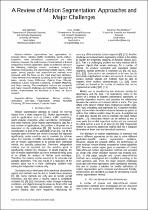JavaScript is disabled for your browser. Some features of this site may not work without it.
- ResearchSpace
- →
- Research Publications/Outputs
- →
- Conference Publications
- →
- View Item
| dc.contributor.author |
Mattheus, J

|
|
| dc.contributor.author |
Grobler, H

|
|
| dc.contributor.author |
Abu-Mahfouz, Adnan MI

|
|
| dc.date.accessioned | 2021-02-09T11:07:55Z | |
| dc.date.available | 2021-02-09T11:07:55Z | |
| dc.date.issued | 2020-11 | |
| dc.identifier.citation | Mattheus, J., Grobler, H. & Abu-Mahfouz, A.M. 2020. A review of motion segmentation: Approaches and major challenges. http://hdl.handle.net/10204/11740 . | en_ZA |
| dc.identifier.uri | http://hdl.handle.net/10204/11740 | |
| dc.description.abstract | Motion segmentation has applications in, amongst others, robotics, traffic monitoring, sports analysis, inspection, video surveillance, compression, and video indexing. However, the performance of most methods is limited compared to human capabilities. Based on extensive literature the following challenges remain: occlusions, temporary stopping, missing data, and segmenting multiple objects. In this paper, several popular and state-of-the-art methods were reviewed, with the focus on the most important attributes. These methods were classified according to the main approach taken, namely Image Difference, Optical Flow, Wavelet, Statistical, Layers, Manifold Clustering, Template Matching, and Deep Learning. The investigated methods are compared and major research challenges are highlighted. Based on the review, improvements are identified as a basis for future research. | en_US |
| dc.format | Full text | en_US |
| dc.language.iso | en | en_US |
| dc.relation.uri | https://www.spu.ac.za/index.php/ieee-imitec-2020/ | en_US |
| dc.relation.uri | https://ieeexplore.ieee.org/document/9334076 | en_US |
| dc.relation.uri | DOI: 10.1109/IMITEC50163.2020.9334076 | en_US |
| dc.relation.uri | 978-1-7281-9520-9 | en_US |
| dc.relation.uri | 978-1-7281-9521-6 | en_US |
| dc.source | International Multidisciplinary Information Technology and Engineering Conference, Kimberley, South Africa, 25-27 November 2020 | en_US |
| dc.subject | 3D scene analysis | en_US |
| dc.subject | Articulated | en_US |
| dc.subject | Computer vision | en_US |
| dc.subject | Factorization method | en_US |
| dc.subject | Manifold clustering | en_US |
| dc.subject | Motion analysis | en_US |
| dc.subject | Motion segmentation | en_US |
| dc.subject | Non-rigid | en_US |
| dc.title | A review of motion segmentation: Approaches and major challenges | en_US |
| dc.type | Conference Presentation | en_US |
| dc.description.pages | 8pp | en_US |
| dc.description.note | Copyright: 2020 IEEE. This is the pre-print version of the work. | en_US |
| dc.description.cluster | Next Generation Enterprises & Institutions | |
| dc.description.impactarea | EDTRC Management | en_US |
| dc.identifier.apacitation | Mattheus, J., Grobler, H., & Abu-Mahfouz, A. M. (2020). A review of motion segmentation: Approaches and major challenges. http://hdl.handle.net/10204/11740 | en_ZA |
| dc.identifier.chicagocitation | Mattheus, J, H Grobler, and Adnan MI Abu-Mahfouz. "A review of motion segmentation: Approaches and major challenges." <i>International Multidisciplinary Information Technology and Engineering Conference, Kimberley, South Africa, 25-27 November 2020</i> (2020): http://hdl.handle.net/10204/11740 | en_ZA |
| dc.identifier.vancouvercitation | Mattheus J, Grobler H, Abu-Mahfouz AM, A review of motion segmentation: Approaches and major challenges; 2020. http://hdl.handle.net/10204/11740 . | en_ZA |
| dc.identifier.ris | TY - Conference Presentation AU - Mattheus, J AU - Grobler, H AU - Abu-Mahfouz, Adnan MI AB - Motion segmentation has applications in, amongst others, robotics, traffic monitoring, sports analysis, inspection, video surveillance, compression, and video indexing. However, the performance of most methods is limited compared to human capabilities. Based on extensive literature the following challenges remain: occlusions, temporary stopping, missing data, and segmenting multiple objects. In this paper, several popular and state-of-the-art methods were reviewed, with the focus on the most important attributes. These methods were classified according to the main approach taken, namely Image Difference, Optical Flow, Wavelet, Statistical, Layers, Manifold Clustering, Template Matching, and Deep Learning. The investigated methods are compared and major research challenges are highlighted. Based on the review, improvements are identified as a basis for future research. DA - 2020-11 DB - ResearchSpace DP - CSIR J1 - International Multidisciplinary Information Technology and Engineering Conference, Kimberley, South Africa, 25-27 November 2020 KW - 3D scene analysis KW - Articulated KW - Computer vision KW - Factorization method KW - Manifold clustering KW - Motion analysis KW - Motion segmentation KW - Non-rigid LK - https://researchspace.csir.co.za PY - 2020 T1 - A review of motion segmentation: Approaches and major challenges TI - A review of motion segmentation: Approaches and major challenges UR - http://hdl.handle.net/10204/11740 ER - | en_ZA |
| dc.identifier.worklist | 24113 |






